How Associations can broaden their Educational Offering

Beyond associations
Most medical associations exist to advance the body of knowledge in their field. Surveys and feedback from members of different organisations confirm that education and development is a key motivator to become a part of a professional society.
 Today associations have to decide how to make their academic offering readily available and suitable for the needs of their community. One conference a year cannot ensure that medical professionals are abreast of all innovations and informed about the best standards of patient care. It has long been recognised that the level of each physician varies, so tailored solutions are a must to satisfy unique lifelong learning needs – of those just entering the field as well as the veterans.
Today associations have to decide how to make their academic offering readily available and suitable for the needs of their community. One conference a year cannot ensure that medical professionals are abreast of all innovations and informed about the best standards of patient care. It has long been recognised that the level of each physician varies, so tailored solutions are a must to satisfy unique lifelong learning needs – of those just entering the field as well as the veterans.
The European Society for Immunodeficiencies (ESID) and the International Society of Endocrinology (ISE) are just two of many associations who regard education as the most essential element in achieving their mission. Both societies rely on different activities to reach their goals, such as organising international conferences, supporting regional and national meetings, facilitating collaboration among members, and others. However, with both focusing on disseminating education across geographical borders, they wanted to develop a system that can reach all stakeholders, offer different learning methods and provide the flexibility to study on demand.
Continuous education strategy
A continuous education strategy is an integrated approach that puts education at the heart of the association. It includes three main pillars: online education, blended learning and live events. Each of these approaches encompasses different activities as follows:
-
Online Learning:
-
eLearning courses
-
Webcasts
-
Online forum
-
Blended Learning:
-
Online pre-event test
-
Online post-event test
-
Live events:
-
Annual meeting
-
Workshops and sessions
-
Sessions at endorsed meetings
ESID developed an education portal that includes content scalable to individual objectives and schedules, while also featuring modules that provide CME credits. Some of the results of members using the portal include:
-
Over half of ESID’s members have registered for the portal
-
Over 25% of those users have completed one or more case studies
-
80% of the users agree that these case studies will help them to advance in their professional practice
For ISE, the online portal is being designed as the main hub for all materials. Every healthcare professional will be able to access it and tailor their learning path by choosing what they need to discover at the right time, in the right setting, and getting the best outcomes possible.
A continuous education strategy suggests combining methods such as simulations, scenario-based learning, demonstrations, hands-on workshops, etc. All of these are effective ways of increasing knowledge and practical application, as well as engaging members to participate at live events. Attendees can be involved before, during and after a conference to get the most out of a scientific session through blended learning programmes. This offers unprecedented possibilities for effective and customised learning, the opportunity to measure outcomes, as well as incorporating these interactions into the event itself.
Strategy development
The development of a continuous education strategy requires time and planning. It starts with understanding the needs of members and investing in creating the materials and repurposing the content to fit the different educational methods, and to suit accrediting bodies and lecturers alike. ESID needed over a year to develop the portal with the right content, creating a well-working mix of online and offline learning, and ISE is currently setting on this path too.
Blended learning and eLearning courses can also take a couple of years to be built and fused with other society activities. Once they are ready, everything should be put into action – from the launch and promotion to continuing the expansion of educational methods on offer. And last but not least, associations need to look for opportunities to partner with external organisations, including industry, who also have similar educational targets and objectives.
Broadening Science
The advantages of such an integrated strategy are many: from increasing the society’s direct reach to their audience, as in the case of ESID and ISE, to allowing them to utilise their resources more efficiently. The combination of methods aids the longevity of all content and materials distributed as online webcasts, case-studies, pre-/post- event questions, forums and more. And with the possibility to measure everything, the content can be adapted to the changing needs of the community, ensuring that all members are equipped with the best know-how available.
Whatever the mix of tools, the goal of associations adopting a continuous education strategy is to empower the learner to achieve understanding in a given topic, become self-sufficient, improve workplace performance and ultimately – improve patient care.
This article was provided by the International Association of Professional Congress Organisers, author Louise Gorringe, Director of Association Management Operations, Kenes Group. The Head Office of KENES Group is based in Geneva, Switzerland. For over fifty years, Kenes Group has been creating success stories with associations around the world. We’re experts in helping associations reach their true potential by strategically building awareness, loyalty and satisfaction among current and potential members, as well as stakeholders. www.kenes.com IAPCO represents today 130 companies comprised of over 7500 professional congress organisers, meeting planners and managers of international and national congresses, conventions and special events from 41 countries Email: info@iapco.org // www.iapco.org
Other Articles
About Us
Supported by the Union of International Associations (UIA), the International Association of Professional Congress Organisers (IAPCO) and the Interel Group, the global public affairs and association management consultancy, Headquarters Magazines serve the needs of international associations organising worldwide congresses.















